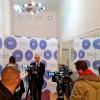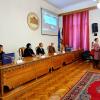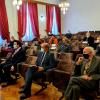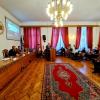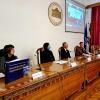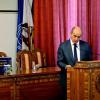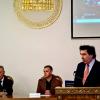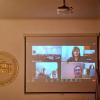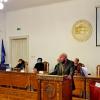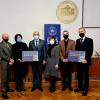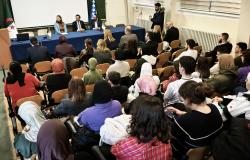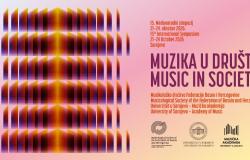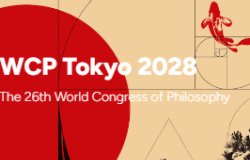Phonetic volume of the Bosnian Linguistic Atlas (BLA) by Senahid Halilović, Mehmed Kardaš, Amela Ljevo-Ovčina and Emira Mešanović-Meša promoted
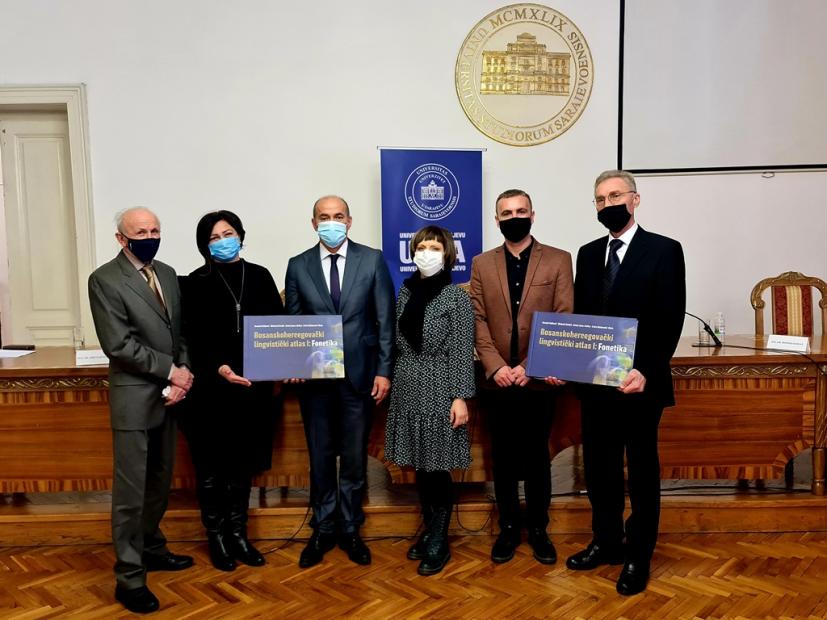
On 18 January 2022, the phonetic volume of the Bosnian Linguistic Atlas (BLA) by Senahid Halilović, Mehmed Kardaš, Amela Ljevo-Ovčina and Emira Mešanović-Meša was promoted by the Federal Ministry of Education and Science and the University of Sarajevo. It is a book that is the result of five years of effort by more than thirty associates of the Slavic Committee. Work on the project began in 2016, and technical assistance in the implementation of the project was provided by ANUBiH and the Institute of Language of the University of Sarajevo. The publishers of the Bosnian Linguistic Atlas I: Phonetics are the Slavic Committee (Sarajevo), the Institute of Language of the University of Sarajevo and the Federal Ministry of Education and Science (Mostar).
The promotion was opened by Prof. Dr. Rifat Škrijelj, University of Sarajevo Rector “We can certainly be proud of such a large and demanding scientific endeavor, which is the result of five years of effort and work of more than 30 associates of the Slavic Committee. This Atlas is not only important for our and international Slavic studies, but also of general interest for the entire social community, because for the first time in the field of linguistics we have a complete overview of the phonetic features of Bosnian dialects.”
Mr. Jasmin Brankovic, Assistant Minister of Science and Technology, Federal Ministry of Education and Science, said that this is a major research and publishing project that lasted several decades and is of key importance for the linguistics of our country and for Bosnia and Herzegovina in which unfortunately does not have too many works of this type.
Professor Senahid Halilović is a member of the team that completed the work on the first volume of the “Bosnian Linguistic Atlas I: Phonetics.” On this occasion, he stated that this is a work created by generations, in the production of which more than 60 associates participated, who collected material in the 70s and 80s.
“And then from 2016 to last year, more than 30 of us clung to that material and made the first work of its kind in Bosnia and Herzegovina and the wider environment. In this first fundamental volume, we presented the most important phonetic phenomena in Bosnian speeches, showed all the diversity and complexity of the Bosnian dialect landscape, before the violent migrations from '92 to '95,” said Professor Halilović. He stressed that this work is important not only for the history of language and dialectology, Slavic studies and linguistics in general, but also for the state of Bosnia and Herzegovina. “In it, we have shown, in addition to everything that is important for linguistic science, and something that is unique in Europe. Our dialect landscape is extremely complex and colorful thanks to the unique mix of population in Europe,” said Professor Halilović.
Professor Josip Baotić expressed his satisfaction that he welcomed the end of the project in which he has been participating since its beginnings, and the realization of which, unfortunately, was not welcomed by some of its initiators.
“Its realization was not welcomed, among others, by academicians Prof. Dr. Jovan Vuković, Dr. Asim Peco, Dr. Dalibor Brozović, who founded the project and participated in its realization,” said Professor Baotić.
The atlas was promoted by Prof. Dr. Jožica Škofic (Fran Ramovš Institute for the Slovenian Language, Slovenia), Prof. Dr. Gleb Petrovich Pilipenko (Institute of Slavonic Studies, Russian Academy of Sciences, Russia), Prof. Dr. Helena Grochola-Szczepanek (Instytut Języka Polskiego PAN, Poland) and Prof. Dr. Josip Baotić (University of Sarajevo).
The promotion of the book was moderated by Doz. Dr. Elma Durmišević-Cernica.
The Bosnian Linguistic Atlas I: Phonetics deals with material collected from 1975 to 1986 and from 2016 to 2017. in 230 local speeches throughout BiH. The speech of Bosniaks was examined in one hundred places, the speech of Serbs in eighty and the speech of Croats in fifty. Thirty-seven examiners participated in the fieldwork. The first phase of collecting material (1975-1986) took place within the macro-project “Bosnian-Herzegovinian dialect complex - synchronous description and attitude towards modern standard language” of the Institute of Language in Sarajevo. This material was published and processed in five sequels in the Bosnian Dialectological Collection and in other publications. The mentioned project was interrupted in 1992, so that the planned synthesis on Bosnian speeches was missing. Field work continued in 2016 and 2017 within the BLA project and organized by the Slavic Committee. Although the dialect situation changed significantly with population movements and migrations during the war in the first half of the 1990s, material collected from 1975 to 1986 and that dating from 2016 and 2017 form a whole that enables the creation of a national linguistic atlas.
The book has an introductory and main part and an appendix.
The introductory part contains basic notes on the project, a list of 230 examined speeches, an alphabetical list of examined speeches, a list of letters of the examined speeches, a list of examiners with the number of completed questionnaires, a phonetic transcription system, an alphabetical list of lexemes and dialect maps. subdialects in Bosnia and Herzegovina. The phonetic transcription system for BLA is basically the one adopted in the All-Slavic Linguistic Atlas (OLA), represented in both the European Linguistic Atlas (ALE) and the All-Carpathian Dialectological Atlas (ODA). The section “Etymology” uses a transcription for Proto-Slavic and other older linguistic phases that is in line with the practice in OLA and Slavic literature. The register of lexemes covered by the Questionnaire has been translated into English, French, German and Russian. Maps of dialects and subdialects were prepared not only on the basis of BLA material but also on the basis of insight into the dialectological literature. Speeches within the borders of Bosnia and Herzegovina belong to four dialects of the Štokavian dialect: East Bosnian, East Herzegovinian, Posavina (or Slavonian) and Western. Bosniaks and Croats, and a small number of Serbs, speak the East Bosnian and Western dialects; Bosniaks, Croats and Serbs speak East Herzegovinian; Posavina is spoken only by Croats.
The main part is devoted to the most important phonetic phenomena; out of a total of 181 questions, 63 fall on vocalism and 118 on consonantism. It contains transcribed records from 230 examined speeches (“Material”), linguistic interpretation of material (“Commentary”), morphological analysis and etymology of lexemes (“Etymology”) and maps on which material represented by symbols enables monitoring of isophones in their entirety, determining the range of individual phenomena , specifying dialect boundaries and considering the horizontal stratification of Bosnian dialects, and next to each map there is an interpreter of signs ("Legend") and data on the representation of certain forms with a graphic representation ("Percentages and diagrams"). The comments have a mostly unique composition: the commentary contains four smaller sections (frequency of certain forms; their territorial distribution; share in Bosniak, Croatian and Serbian dialects; references to selected dialectological literature and links to three international linguistic atlases in which individual local dialects are represented. from the BLA), and the etymological commentary two (morpheme word structure; references to representative etymological dictionaries). The maps were made by Prof. Dr. Nusret Drešković, GIS expert from the Faculty of Natural Sciences and Mathematics in Sarajevo. On the maps, there are letter designations of the examined speeches, because they are more informative than the numerical designations, common in linguistic atlases. These markings have three colors (green: Bosniak speeches; blue: Croat speeches; red: Serb speeches), in order to simultaneously reflect differences in speeches with regard to the ethnicity of the informants. The legend contains symbols of various phonetic characters of the word represented on the map. Next to each map there is a section with percentages and color charts, as a contribution to the overall perception and understanding of the analyzed phenomenon.
The appendix contains an alphabetical index with more than four thousand different forms obtained in response to 181 questions, a list of references referred to in the text, and a list of abbreviations, labels, and graphic symbols used in the book.
The Bosnian Linguistic Atlas is the first linguistic-geographical endeavor of this kind not only in BiH but also in the area of the Štokavian dialect and in general within the Central South Slavic language of the diasystem.
At the end of 2020, the Slavic Committee published an electronic edition of the first volume of the first BLA.
(Access: https://slavistickikomitet.ba/Bosanskohercegovacki_lingvisticki_atlas.pdf.)
On the Bosnian Linguistic Atlas I: Phonetics, eminent Slavic dialectologists said the following:
“Bosnian Linguistic Atlas I: Phonetics is a great and serious result of important dialectological research conducted in the 1970s and 1980s and in recent times. Now the dialectal situation has changed, but the material has been reliably recorded, and is therefore valuable. The valuable thing is that the work brought together excellent researchers and brought a result of extraordinary value. The achievement is the top result of Bosnian and related philology. He is huge, serious and welcome, top in every segment. ”
Academician Josip Lisac (University of Zadar, Croatia)
“Bosnian Linguistic Atlas I: Phonetics is an example of precise work in the field of linguistic geography thanks to the expertise of an excellent team of linguists led by project manager Senahid Halilović. The first volume, dedicated to phonetics, is a comprehensive and complex research of phonetic phenomena that appear in the dialects of Bosnia and Herzegovina at the end of the 20th and the beginning of the 21st century. Differences in traditional dialectsteams are rapidly disappearing due to, among other things, increased social mobility, so the atlas is an important testimony to the linguistic and cultural heritage of dialects in Bosnia and Herzegovina. The Bosnian-Herzegovinian linguistic atlas contains an in-depth analysis of the presented word forms and phonetic phenomena using a synthetic approach, in addition, linguistic data are presented on carefully and legibly prepared language maps. An important advantage of the work is its general availability, because, in addition to the printed edition, the Atlas will also be available in an electronic version. The valuable linguistic materials contained in the Atlas and metadata can be used for comparative analyzes on a broader pan-Slavic level. ”
Prof. Dr. Helena Grochola-Szczepanek (Polish Institute of Polish Language, Poland)
“Bosnian Linguistic Atlas I: Phonetics (BLA) is an original scientific work of associates of the Slavic Committee in BiH, headed by Prof. Dr. Senahid Halilović. The monograph fills a gap in the geolinguistic research of the Central South Slavic idiom. The Bosnian-Herzegovinian Linguistic Atlas I: Phonetics (BLA) is an extremely valuable contribution to South Slavic, Slavic and European dialectology and geolinguistics, as well as Indo-European studies, because in one place it brings rich dialectal material that has not been methodologically presented or linguistically analyzed.
Prof. Dr. Jožica Škofic (Fran Ramovš Institute for the Slovenian Language, Slovenia)
“Bosnian Linguistic Atlas I: Phonetics - is a thorough publication that world Slavic studies has been waiting for a long time. (...) The peer-reviewed publication represents value for world science (...) ”
Dr. Gleb Petrovich Pilipenko (Institute of Slavonic Studies, Russian Academy of Sciences, Russia)




